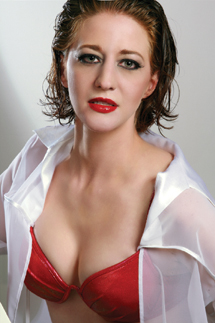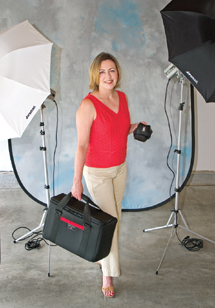The Tools I Use; What’s In My Gear Bag And Why
"Silver white winters that melt into springs."--Oscar Hammerstein II
The idea behind this story was to provide insight into the photo gear I own and use, all of which was purchased from Shutterbug advertisers. During the review process many different photographic products pass through my hands but contrary to what you may think they don't stay there and have to be returned to the manufacturer. While this is an up-close-and-personal look at my equipment, it does not constitute an endorsement. It's just a statement of fact. You can use whatever brand of camera, lens, or software that fits your photographic style and budget, but if you've ever wondered "how did he do that?"--now you'll know.
 |
Camera Systems
When Mary and I sold our studio in 1995 we also sold almost all the cameras
and that gave me an opportunity to start over with new gear. Shutterbug contributor
Rick Sammon suggested a look at the Canon EOS system and I purchased a used
body, lens, and flash to get started. Shortly thereafter I was hooked and began
using Canon film, then digital, SLRs for most of my personal and professional
photography. My main camera is an EOS-1D Mark II but after the full-frame EOS
5D was introduced I purchased a factory refurbished model. New, used, or refurb,
it doesn't matter to me because I'm actually going to use the camera,
not "wrap it up and kiss it goodnight."
 |
|
|
 |
|
|
Over the years I've converted a number of Canon D-SLRs for dedicated infrared capture and right now I am using a Rebel XTi that was converted by Life Pixel. I also purchased a used Rebel XT and had it converted using Life Pixel's Enhanced Color IR that allows more color to pass and is supposed to produce more saturation and color range, but I'm unconvinced about the value of this particular conversion. Because IR capture is difficult to predict, perhaps I need more time with the camera. Both Rebels and the EOS 5D are used with Canon's battery grips because I like the extra battery capacity, enjoy the vertical shutter release, and find it makes the Rebels easier to shoot because of added bulk to their otherwise tiny frames.
 |
|
|
 |
|
|
I still have what seems like lots of film cameras, including a Leica M6 TTL, Zeiss Ikon SW, and Hasselblad Xpan along with a few lenses. There are even a few medium format cameras, including a Hasselblad 503, Flexbody, and 35mm Leica R8 that are awaiting digital backs, although Leica threw a monkey wrench into my plans by discontinuing the DIGITAL-MODUL-R. I don't use my film cameras much but enjoy the lightweight and stealthy, precise quality the M6 and Zeiss Ikon bring to my photography, and using these finely-crafted cameras just feels good. No digital camera I have used (haven't tried an M8 yet) comes close to recapturing my original excitement of making photographs with these particular imaging instruments.
 |
|
|
Lenses
I prefer prime focal lengths to zooms for portraits but don't have any
hard-and-fast rules about it. I'm not a lens snob. My Canon-mount lenses
include the EF 85mm f/1.8 USM for indoor portraiture and the EF 135mm f/2.8
SF that lets me apply soft focus effects--or not--outdoors. I like
to use longer lenses for full-length portraits outdoors because I like the perspective
and often thought about adding a 200mm for outdoor portraits.
 |
Did somebody say zooms? My favorite lens for photographing cars is the Canon
EF 16-35mm f/2.8L USM, my only lens in their expensive L-series. My two Image
Stabilized lenses are workhorses: The EF 28-135mm f/3.5-5.6 IS USM lens is a
bargain considering its versatility and it's the one lens I'd recommend
to all Canon shooters. The other is the EF 70-300mm f/4-5.6 IS USM that I use
for travel, fashion runway, and some sports photography.
As far as non-Canon lenses are concerned, I really like Tamron's Di II
digital-only lenses and love the SP AF11-18mm F/4.5-5.6 Di II LD Aspherical
lens for digital infrared photography because of its wide field of view. On
the other end of the focal length spectrum, I like the performance of the modestly
priced but high-quality Pro-Optic Multi-Coated 2x Tele-Converter.
 |
|
|
Lighting
This may surprise you but since selling our studio, my lighting gear consists
of a couple of Canon EX shoe-mount flashes and a motley assortment of inexpensive
and hand-me-down monolights. I don't like the situation but like most
of you I don't have the budget to replace these lights with high-end European
or Japanese monolights. Most of the time I make do with a portable kit that
includes two Flashpoint DigiPoppers, two Westcott collapsible umbrellas, a pair
of Manfrotto light stands, and a Flash Waves wireless sync kit--all packed
into a single Lightware case. The DigiPoppers are discontinued and have been
replaced by the rugged and larger Flashpoint 320 at the same price as the lighter
weight DigiPoppers. Flash is metered with a Gossen Luna-Star F2 meter that also
measures ambient light, although I hardly ever use it for that purpose anymore.
Similarly, I have a Color Meter III F that I seldom use.
 |
|
|
Digital Darkroom
I've been an Apple Macintosh user since '84 and that remains my
computer of choice for serious imaging. Currently that translates into a Mac
Pro running OS 10.4.11 with 5GB RAM and four hard drives providing a total of
2.5TB of storage. The monitor is a 23" Cinema HD Display calibrated with
a ColorVision Spyder2. My laptop is a used PowerBook G4 running Mac OS Leopard
that I'm still wondering why I bothered to upgrade. I also have a Compaq
Presario where I run Microsoft Office, especially Outlook, and use it to test
all Windows-based software for Shutterbug. It is running Windows XP Home and
has an Apple 22" Cinema HD Display (yes, it works just fine) attached
and is calibrated with the same Spyder2.
 |

















































